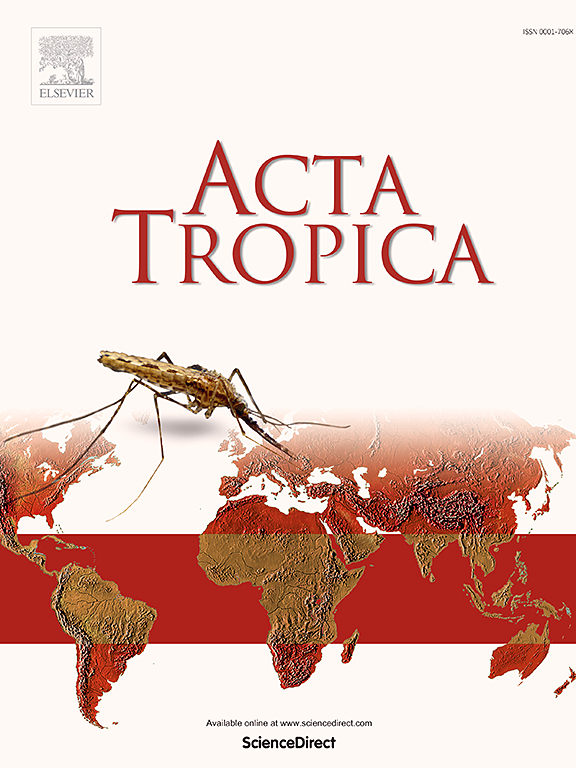An improved, multimodal, trap for Triatoma infestans, a kissing bug vector of Chagas disease: laboratory tests
IF 2.1
3区 医学
Q2 PARASITOLOGY
引用次数: 0
Abstract
Triatomines, commonly known as kissing bugs, are vectors of the protozoan Trypanosoma cruzi, responsible for Chagas disease in the Americas. In South America, Triatoma infestans is one of the main vectors of that disease. Triatomine control programs require practical, economical, and reliable tools and methods to monitor infestation in homes, especially when insects are present at low densities, and detection sensitivity must be improved. In a previous work, a sticky pitfall trap baited with a human-based synthetic odor blend (L(+)lactic acid + valeric acid + ammonia) was developed. That trap captured a significant number of bugs although less than a host-baited trap. In the present work, we added a CO2 source (a yeast culture) and a heat source (heated paraffin wax) to that odor blend, and tested the resulting multimodal bait in the trap used previously. As the resulting multimodal trap captured as many bugs as a host-baited trap, we also aimed at evaluating the role of the bait constituents in its capture performance. Tests were conducted with two nymphal stages (third and fourth) of T. infestans, within three experimental boxes (containing one trap each) under semi-controlled laboratory conditions, overnight. The percentage of insects captured per trap per treatment was statistically analyzed using a binomial Generalized Linear Mixed Model. The multimodal trap captured as many fourth and third instar nymphs as a trap baited with a mouse (80 % for fourth instar and 57.1 % for third instar nymphs) and more than an unbaited trap (20 % for fourth instar and 14.3 % for third instar nymphs). While the yeast culture plus the odor blend evoked a very good capture performance, (64.3 % for third instar nymphs), the heated paraffin wax appeared to decrease the bait performance when the yeast culture was absent (7.1 % capture for third instar nymphs). Different hypotheses are proposed to explain this. Our results suggest that the addition of the yeast culture to the odor blend was responsible for the improvement of the bait. In summary, we reached a high-performance trap to capture T. infestans nymphs in the laboratory. This trap deserves to be tested in a field setting.

一种改进的多模式陷阱,用于诱捕恰加斯病的一种吻虫媒介——斑鼻虫:实验室检测
锥蝽,俗称吻蝽,是原生动物克氏锥虫的载体,是美洲恰加斯病的罪魁祸首。在南美洲,感染三角瘤是该疾病的主要媒介之一。Triatomine控制方案需要实用、经济、可靠的工具和方法来监测家庭中的虫害,特别是当昆虫以低密度存在时,检测灵敏度必须提高。在之前的工作中,开发了一种以人为基础的合成气味混合物(L(+)乳酸+戊酸+氨)为诱饵的粘性陷阱。这个陷阱捕获了大量的虫子,尽管比宿主诱捕器少。在目前的工作中,我们在气味混合物中加入了二氧化碳源(酵母培养物)和热源(加热的石蜡),并在之前使用的陷阱中测试了得到的多模态诱饵。由于由此产生的多模式诱捕器捕获的臭虫数量与宿主诱捕器一样多,我们还旨在评估诱饵成分在其捕获性能中的作用。在半控制的实验室条件下,在三个实验箱中(每个箱中装有一个诱捕器)对两个若虫期(第三期和第四期)进行夜间试验。采用二项广义线性混合模型统计分析每个处理每个陷阱捕获的昆虫百分比。多模式诱捕器捕获的4龄和3龄若虫数量与鼠饵诱捕器相同(4龄为80%,3龄为57.1%),高于无饵诱捕器(4龄为20%,3龄为14.3%)。酵母培养物加气味混合物对三龄若虫的捕获率为64.3%,加热后的石蜡对三龄若虫的捕获率为7.1%。人们提出了不同的假设来解释这一点。我们的结果表明,在气味混合物中添加酵母培养物是改善诱饵的原因。实验结果表明,本实验获得了一种高效诱捕装置。这个陷阱值得在实地环境中进行测试。
本文章由计算机程序翻译,如有差异,请以英文原文为准。
求助全文
约1分钟内获得全文
求助全文
来源期刊

Acta tropica
医学-寄生虫学
CiteScore
5.40
自引率
11.10%
发文量
383
审稿时长
37 days
期刊介绍:
Acta Tropica, is an international journal on infectious diseases that covers public health sciences and biomedical research with particular emphasis on topics relevant to human and animal health in the tropics and the subtropics.
 求助内容:
求助内容: 应助结果提醒方式:
应助结果提醒方式:


